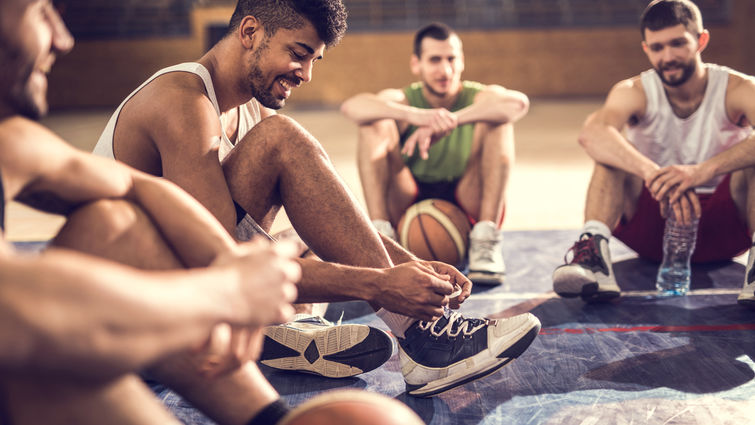
From the time we are young, and well into our later years, it has been drilled into us that an active lifestyle is key to a healthy long life. But nothing hinders the benefits of exercise more than sport injuries. On average 8.6 million sport and recreational injuries are reported each year, according to CDC studies. Of those reported, 2.6 million occur in children 0-19 years old.
While there are preventative steps adults and children alike can take, Joseph N. Liu, MD, an orthopedic surgeon for Loma Linda University Medical Center, says it’s important to remember that there is always a risk of injury with recreational activities and that some injuries come from wear over time.
Liu shares the five most common sport injuries to watch out for, treatment options, and what you need to get back out into the game.
- Ankle sprains. An ankle sprain occurs when one or more ligaments supporting a joint are stretched or torn. This can happen when the ankle lands or twists awkwardly with the weight of the body fully on it. Sports movements prone to this kind of injury include jumping such as basketball, football and soccer. Signs include pain when bearing weight on the foot, swelling, bruising and restricted motion. There are three grades for sprains, ranging from mild to severe, which affect everything from whether a surgery is needed to recovery time. Liu says most ankle sprains won’t need surgery and the key is proper therapy. “The longer a patient stays off their ankle, the longer it takes for them to strengthen it and recuperate the muscle to play again,” Liu says. He adds that with ankle sprains it’s common to feel pain months after it’s healed, but that doesn’t mean you can’t play. With proper shoes, rest and communication with your physician, you’re good to go.
- ACL injuries. An ACL injury is a tear or sprain of the anterior cruciate ligament — a major ligament in the knee. Liu says the biggest sign of a torn ACL is feeling or hearing a “pop” in the knee along with swelling, unsteadiness and pain to bear weight. This type of injury is most likely to occur with sudden stops or changes in direction, causing the foot to stay in one direction while the body and knee go in another. Typically, this occurs in sports such as basketball, downhill skiing, football and soccer. Liu says surgery for ACL injuries is common to maintain rotation and stability in the knee, and that without surgery, the body relies on other cartilage for protection. This can put the athlete at risk for arthritis later in life. Surgery is typically outpatient with 9-12 months of recovery time, including physical therapy. “I tell my patients with these injuries that the longer they wait to return to sports the better, because they will build endurance, strength and decrease their chance of reinjury.”
- Knees and Meniscus injuries. There are a number of injuries that can cause pain in the knee, but one of the most common is a meniscus tear. These tears happen when the cartilage is torn by a twisting movement while there is a lot of weight on it or from years of wear. Liu says these injuries are more common in the “weekend warriors” or those exercising over age of 40. “With these injuries, it’s important to remember one action may not cause it,” Liu says. “We put a lot of mileage on our knees over time, and for patients that means menisci from wear is stiffer and predisposed to tearing.” Liu adds these injuries often are asymptomatic until the tear has worsened. Surgery is reserved for severe tears where the patient’s ability to move is blocked by the tear or physical therapy and other non-surgical options have not helped.
- Shoulder and rotator cuff injuries. The rotator cuff is the group of muscles and tendons that surround the shoulder joint, keeping the upper arm bone within the shoulder socket. Like meniscus injuries, these often are asymptomatic, worsen with age and don’t require surgery unless other methods have not worked to heal the tear. Typically, this type of injury occurs from overhead sports such as baseball, swimming, tennis and volleyball or activities like CrossFit. “Our bodies weren’t designed to do a lot of work overhead,” Liu says. “As these activities become more common, these types of injuries will be too.” Liu adds that back strengthening activities are one way to prevent this type injury.
- Post-traumatic arthritis. While not a direct sports injury, Liu says arthritis and previous injuries to the joints or cartilage, go hand-in-hand. Often arthritis lays dormant until exasperated by activity. Early symptoms include stiffness, swelling, and pain from movement. Initial treatments are non-surgical including ice, rest, physical therapy and weight optimization. Joint replacement for arthritis occurs in extreme cases where there is limited mobility and surgery will improve it. Liu says the key to treating arthritis is staying active. “When arthritis patients are active, they increase their bone and muscle health,” Liu says. “This creates a natural resilience that keeps their symptoms at bay.”
With these five injuries in mind, Liu’ says his key takeaway is to play, be active, do the things you love, but be smart. Take preventative steps where you can, listen to your body and consult your doctor as soon as an injury happens.
For more information regarding Loma Linda University Health’s orthopedics sports medicine and orthopedics services, visit the website or call 909-558-2808.
